Jay asked a really, really long time ago about the Banjo-Kazooie games. I’ve never played them (I’m sorry, don’t hurt me!) but they always seemed to be full of charm, so let’s take a look:
Can you look at how Grunty’s and Jamjars’ rhyming was handled in the Japanese versions of Banjo-Kazooie and Banjo-Tooie? Thank you.
Grunty has a nice-sized scene right at the start of the game, which is handy, so the first thing I did was record some videos of both versions of the game. The original English release is on the top, and the Japanese release is below it:
As we’ve seen already, rhyming isn’t really a big thing in Japanese – the language is built upon a syllabary in which almost every single syllable automatically comes with a dozen or so of rhyming syllables. That’s Japanese poetry isn’t so much about rhyming, and why you get things like haiku and tanka instead. And it might be why a lot of Japanese songs tend to sound odd at first – rhyming isn’t always there, although rhythm and meter are.
Anyway, because of this, translating rhymes into Japanese is one of those tough things that Western language->Japanese localizers have to battle with. In the case of Grunty here, the Japanese localizers removed the rhyming and tried to make up for it in a few different ways:
- First, Grunty was given an “old lady” Japanese speech style. This is a pretty standard thing, and if the game had originally been Japanese I feel this is the most that would’ve been done with her text.
- This style was altered a little further into something a bit more unique – for example, the “old people” speech style often ends sentences with じゃ, pronounced “ja”. It’s basically a variation of だ or です, which mean something like “to be” or “is”.
In the case of Grunty, this was changed from the regular “old people” じゃ to ぢゃ, which is also pronounced “ja” but is a REALLY unusual and unique way to write it. The localizers were clearly trying to give Grunty an especially unique speaking style. - The rhyming was removed, but the localizers opted to have her hold some of her vowels extra long. Even if you don’t know Japanese, you can sort of see it in work!
![How did I get these screenshots and these videos? Uhh, look over there! *runs* How did I get these screenshots and these videos? Uhh, look over there! *runs*]()
So this is another level of uniqueness the localizers tried to add to her text.
The end result is that Japanese Grunty speaks in a unique, unusual way. But the flow of the scene and the charm of the original rhyming text is lost in translation. It’s one of those situations where no matter what you do, something’s going to be lost. It also makes me wonder if some big fans of the series in Japan have made sites or done translation patches that try to translate the game the way they think it should’ve been translated. That’d be interesting to see!
All that aside, how does the full scene compare when translated into Japanese? Here’s an attempt to show it, but keep in mind that as this is a translation of a translation, even more is lost here:
| English Version | Japanese Version | Basic translation |
| Grunty: Dingpot, Dingpot by the bench, who is the nicest looking wench? | Grunty: ナベの ディングポットよ! 1ば~~~ん きれいなのは ダ~~~レぢゃ? | Grunty: O Dingpot the pot! Whooooo is the prettieeeest of all? |
| Dingpot: Why it’s Grunty any day, she really takes my breath away…Cough! | Dingpot: それは もちろん! あなた、グランチルダさまです! (トホホ、またかヨ...。) | Dingpot: Why, you, of course, Mistress Gruntilda! (Tohoho, not again…) |
| Grunty: Yes you’re right, I’m rather proud, my looks stand me out from the crowd! | Grunty: よろし~~~い! わた~~~しは、きれ~~~い。 | Grunty: Eeeexcellent! Iiiii am preeeetty. |
| Dingpot: Err…but there IS this girl… | Dingpot: おっと、 こんなきれいなコが... | Dingpot: Oh, there’s a girl this pretty… |
| Grunty: What d’you mean, this cannot be, there’s no one prettier than me! | Grunty: な~~~んぢゃと! わしより きれいなコなど おるわけな~~~い! | Grunty: Whaaaaat?! There can’t possibly be a girl prettier than meeeee! |
| Dingpot: Why, it’s Tooty, young and small, she’s the prettiest girl of all! | Dingpot: 「チューティ」 という わかくて、かわいいコです! | Dingpot: She’s a young and pretty girl named “Tooty”! |
| Grunty: No no no you must be mad, nicer beauty can’t be had! | Grunty: バ~~~カいってんぢゃないよ! そんなコがおるわけな~~~い! | Grunty: Don’t be stuuuuupid! There can’t possibly be such a giiiiirl! |
| Dingpot: Unfortunately I think you’ll find, it’s Tooty, she’s cute and kind! | Dingpot: いいえ! チューティが 1ばんです! | Dingpot: No! Tooty is the prettiest! |
| Grunty: Well… We’ll see about that! | Grunty: ホウキよ、チェックに行くよ! | Grunty: Broom! Let’s go check! |
As you can see, although the rhyming isn’t in the Japanese translation, it’s definitely not normal-looking or normal-sounding text. It’s still lacking, but it was probably as good as an attempt as it could possibly get.
There are a few other things of note too:
- The Japanese translation has to specify that Dingpot is a pot. The English writers didn’t specify this because it was assumed that players would immediately make the name connection.
- Dingpot calls Gruntilda “Grunty” in the original English text, which suggests a level of familiarity. In the Japanese translation, Dingpot refers to her in a very formal way, using her full name and a “-sama” name suffix. This equates to something akin to “Mistress Gruntilda”.
- The “Mirror, mirror on the wall” reference has gone missing in the translation.
- The joke about taking breath away and coughing is gone. It’s replaced with “(Not again…)” which refers to the fact that Grunty apparently asks this question a lot.
- In the Japanese translation, Grunty calls out to the broom, but this wasn’t in the original text at all.
- The final line, “We’ll see about that!” is translated as “Let’s go check!” Although this is an okay translation, I can’t help but feel that the original line was more of a “Not if *I* can help it!” threat rather than a, “Let’s go confirm if this is true!” sort of thing. Especially since she already just saw Tooty’s image in the pot.
Whew! So there’s actually a lot going on here, even in just this tiny intro scene! Hopefully that answers some questions about Grunty, rhyme translation into Japanese, and all sorts of other stuff!
As for the Jamjars character in the sequel, for those not in the know, he’s a drill sergeant type of character who sings and rhymes drill songs in English:
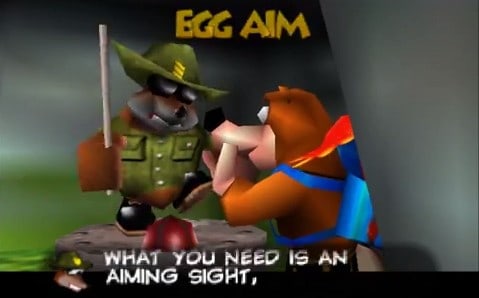 | 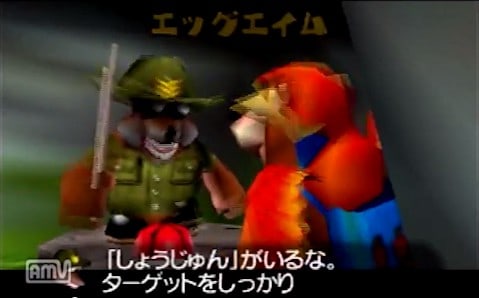 |
| English release | Japanese release |
As with Grunty, the translation lacks the rhyming text found in the original script. Unlike with Grunty, though, his text doesn’t seem to have been given as much attention, so he mostly just comes off as an assertive guy. And the drill song music that plays in the background doesn’t match up with the words or the flow of the words at all – in Japanese, he just says regular explanatory stuff.
Anyway, hopefully that helps answers those questions! And someday I’ll play these games, I swear!

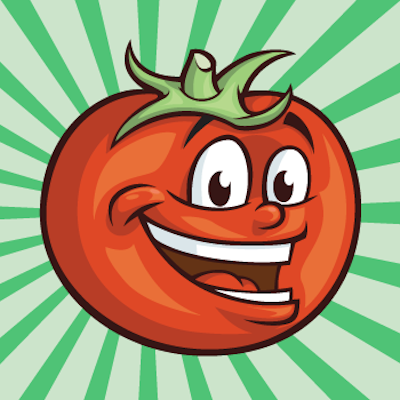
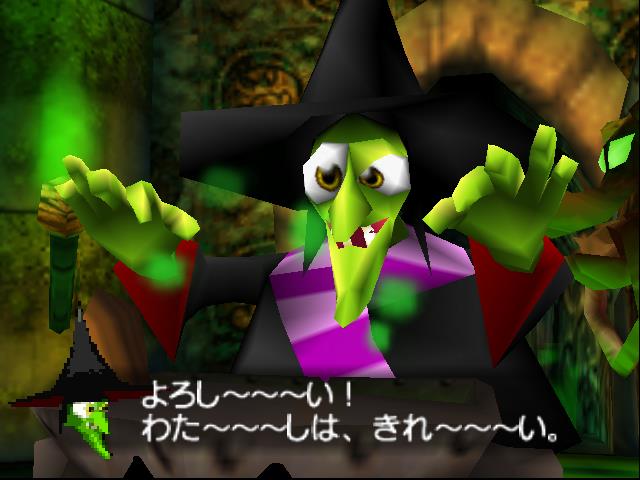
![Passport to MOTHER 2 [Learn Japanese!] Passport to MOTHER 2 [Learn Japanese!]](https://legendsoflocalization.com/wp-content/uploads/2018/05/pp-m2.jpg)
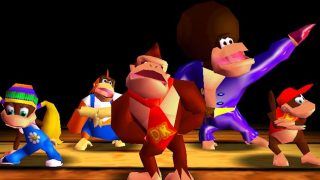
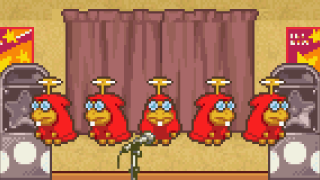
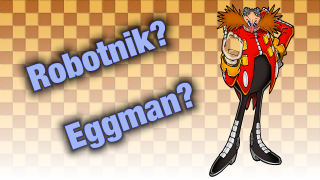
It appears that both Grunty and Dingpot’s dialogue feature the “ko” character written in katakana on multiple occasions, even though the remainder of the text is primarily in hiragana (such as when Dingpot says こんなきれいなコが...). I feel that disrupts the flow of the speech a bit, and I also can’t recall seeing that anywhere else before.
Maybe, but for some reason it didn’t really strike me as too out of place. By using it instead of hiragana it makes it obvious what’s being intended rather than using kanji. I’ve seen that sort of thing often enough in some of my own translation work that I didn’t even really think about it until you pointed it out.
Wait, if Gruntilda doesn’t rhyme in the Japanese version, then how do the translators handle the scene in the sequel where Mingella and Blobbelda say they’re not telling her how they’ll get her body back unless she stops rhyming.
Oh noooo I gotta do more research
Ha, good question. Just a wild guess, but maybe Mingella tells Grunty to stop stressing random vowels? It seems to be her shtick in the Japanese version, much like rhyming was in the English version.
Come to think of it,Klungo has a tendency to elongate certain words as well in the English version, especially “mistresssssssss.” Wonder if he still does that in the Japanese version, considering it already seems to be Gruntilda’s thing.
Don’t worry, one day you will play them. Whether you like it or not. ; )
Oooh, fascinating stuff! I know this series is not without its Japanese fans, and they do seem to enjoy its quirkiness just as much as its Western fans do, so I would hope the localization would still be up to snuff!
The elongated vowels bit reminds me of the way the Wicked Witch from the Wizard of Oz movies talks, actually: “Poppieees! Poppies will put her to sleeeep!”
Also, for some weird reason, some part of me expected Grunty’s voice mumble to sound different in the Japanese version, and I… I don’t know why.
Looks like in those videos, the cutscene is out of sync with the music. Nintendo 64 emulators are pretty bad.
All the more reason to play on a real N64
I actually recommend the 360 versions for those who own that system. They aren’t emulated, they’re proper ports. They’re very well done, though as we are all nitpickers I thought I’d point out that they removed any and all references to Nintendo-owned properties (for obvious legal reasons). Namely, images of Donkey Kong, the Nintendo logo, things like that. They’re not too big a deal though. Also, they finally, at long last, implemented “Stop & Swop” into the games.
Fun trivia: The Japanese version of Banjo-Tooie was censored in some places. The pig child in Jolly Roger’s Lagoon is no longer mutated and doesn’t have a third arm anymore. And the scene at the end where the characters play kickball with Gruntilda’s decapitated head replaces it with a bag (with the implication that the head’s inside).
that’s pretty interesting, I remember the Gruntilda head scene grossed me out when I was a girl, so I can see why they’d change it. Do you have video of it?
Not the best quality, but you can see it here:
http://www.youtube.com/watch?v=pkNT1A477UQ
Ha! Well, on the one hand, yeah playing kick-ball with a skull is kinda gross, but on the other hand, the skull is still alive so it isn’t so morbid as it could have been. The funny thing is the bag being kicked around very obviously has the witch inside because she’s still talking to them, and that eyeball still pops out of her head, and somehow out of the bag, and still manages to be just as gross.
I understand that Japan has a much bigger problem with decapitation than the US does. Not that the US doesn’t have issues with it (check out the Highlander animated series at some point, they actually made all the immortals swear a no killing truce to remove any reason for them to decapitate each other in the show), but with Japan, it seems more enforced in video games. Didn’t they alter a scene in Xenosaga Ep. 1 to remove some decapitation, or is it actually worse in Japan? I really can’t remember.
But in Mazinger Z Boss and his cronies played football with Count Brocken’s head. Even in the recent Shin Mazinger.
You know, thinking about it… I know you’ve said before you’d like to find a series that was originally in English to see how the Japanese translation was handled, and these games might actually be good ones to look into! Writing and humor play a big part in them, and looking at those translations would be interesting! For example, Kazooie constantly calls Bottles the mole by various nicknames referring to his thick glasses, which might be hard to do in Japanese. But on the flipside, lots of characters talk in third person, which is an awkward way of them telling their names to the audience in English–but more normal in Japanese! Might be worth looking into…
I’d be interested in that too. I had heard some time ago that Japanese video game translations (from English) are still very amateurish, akin to the 90’s era translations to English we all had to deal with (this was in reference to the apparently poor quality of Elder Scroll IV: Oblivion’s Japanese translation).
A side note about Jamjars, his lines rhyme with an assumption of UK pronunciation of “Z” (i.e., “Zed”, not “Zee”). This is important, because his lines reference N64 buttons as instructions:
This makes breaking so much fun,
now listen up to how it’s done!
Leap high in the air and then hold Z,
watch Kazooie spin and drill with her head!
Here’s how it plays out in the 360 version:
http://www.youtube.com/watch?feature=player_detailpage&v=7wi05XwUynA#t=827
It mentions that the mirror mirror on the wall reference is lost, but in fact the way you say that in Japanese is 「鏡よ鏡、世界で一番美しいのは誰」so I would argue that 世界で一番きれなのはだーれ is eluding to the snow white title.
Paper Mario was made in Japan, and Kammy Koopa gets ぢゃ too. (By the way, with IME I write じゃ as zya and ぢゃ as dya; do you do this too?)
Makes me curious how something like the Disney adaptation of Snow White was translated into Japanese if the usual iconic mirror mirror scene doesn’t make sense with rhyming, I’ve never seen much of the handheld Kingdom Hearts games but I’m wondering if that iconic scene was left out of the Snow White world for that very reason.
well I’m just wondering if it’s left out I actually have no idea and if I’m right I’m wondering if it’s because of similar translation problems like with Banjo-Kazooie here.